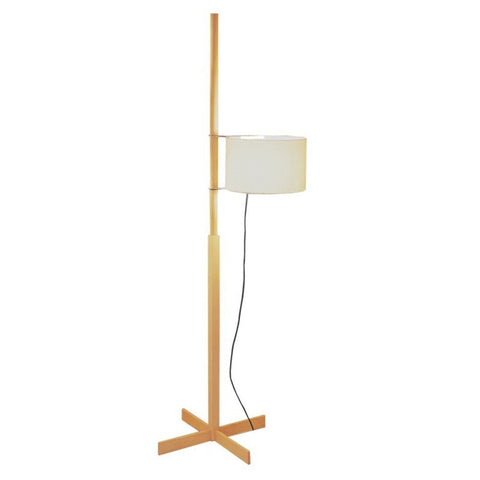With a simple aesthetic and functional design, the TMM lamp by Miguel Milá (Barcelona, 1931) is based on a simple and ingenious mechanism that transforms according to the occasion. A cross-shaped base supports a square section shaft that changes into a circular one when it reaches its midpoint so that the lampshade can move over it. It is, without a doubt, one of the most recognizable silhouettes of Spanish design. Santa & Cole, the company that produces it, describes it as "a manifesto of industrial design conceived in Barcelona."

Designed by Milá in 1961, the TMM (Tramo Móvil Madera) consists of a base or cross-shaped structure that supports a thin shaft, first of square section to become circular halfway through. This is because the drum-shaped screen is threaded into the post to be raised or lowered with only a rubber washer that acts as a stopper and prevents it from falling.
The TMM is perfect in any environment, whether domestic or public. Its design has soft, warm, discreet lines that integrate well with other elements without interfering. Its shade goes up and down also makes it a versatile lamp, which adapts to more social or more intimate situations depending on what is required of it. Another of the designer's icons also appears in this image: the Cesta lamp.
Miguel Milá assures that he is interested in noble materials that know how to age, and this is also due in large part to the fact that he likes a way of working close to craftsmanship, which allows him to correct mistakes and experiment; to introduce changes, corrections and improvements as he progresses, in short, a total control only possible through an attitude of "putting his hands in the dough". Good examples of this type of materials are the Cesta lamps, made of wood; the Manila, made of cane; the M68, made of aluminum; or the methacrylate or natural linen shades of the Americana series.
Milá began to design and produce his pieces, mainly furniture and lamps, through Tramo: a company he founded with architects Pérez Ullibarri and Ribas Barangé, which had intended such as the luminaires in this article: TMC (1958) and TMM (1961). In 1987 the designer won the National Design Award (in its first edition). Just over two decades later, in 2008, he was awarded the Compasso D'Oro for his professional career and his contribution to the dissemination of Spanish design in the world.
The wooden structure of the lamp can be in cherry, wenge, beech, walnut, or natural oak. The height-adjustable shade is made of white or beige cardboard (upper diffuser in the white technical polymer as an option). The lamp is switched on and off by slightly pulling on the cord. In the TMC -Tramo Mobile Chrome- lamp, the metal structure is chrome-plated at the top and black or red at the bottom. The lampshade, similar to that of the TMM, is made of white methacrylate and is also adjustable in height. Again, a simple gesture such as a slight pull on the cable acts as a switch.
In 2011, when the TMC lamp turned 50 years old, changes were made to its design, recovering details of the original design and incorporating improvements to the shade movement system. Naturally, Milá himself oversaw the details and thought that this would be the definitive version. Now, a decade later, the TMC celebrates its 60th anniversary in perfect shape.

